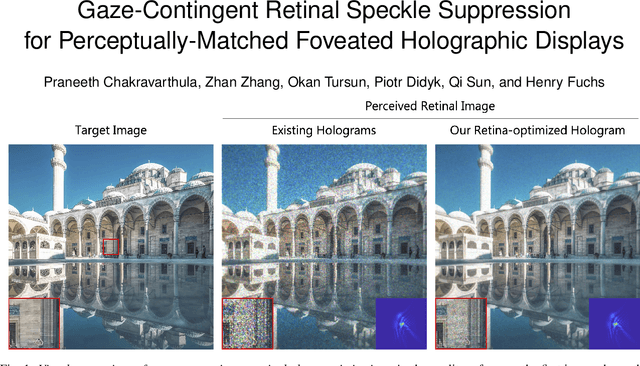Okan Tursun
Università della Svizzera italiana
Gaze-Contingent Retinal Speckle Suppression for Perceptually-Matched Foveated Holographic Displays
Aug 10, 2021



Abstract:Computer-generated holographic (CGH) displays show great potential and are emerging as the next-generation displays for augmented and virtual reality, and automotive heads-up displays. One of the critical problems harming the wide adoption of such displays is the presence of speckle noise inherent to holography, that compromises its quality by introducing perceptible artifacts. Although speckle noise suppression has been an active research area, the previous works have not considered the perceptual characteristics of the Human Visual System (HVS), which receives the final displayed imagery. However, it is well studied that the sensitivity of the HVS is not uniform across the visual field, which has led to gaze-contingent rendering schemes for maximizing the perceptual quality in various computer-generated imagery. Inspired by this, we present the first method that reduces the "perceived speckle noise" by integrating foveal and peripheral vision characteristics of the HVS, along with the retinal point spread function, into the phase hologram computation. Specifically, we introduce the anatomical and statistical retinal receptor distribution into our computational hologram optimization, which places a higher priority on reducing the perceived foveal speckle noise while being adaptable to any individual's optical aberration on the retina. Our method demonstrates superior perceptual quality on our emulated holographic display. Our evaluations with objective measurements and subjective studies demonstrate a significant reduction of the human perceived noise.
Learning Foveated Reconstruction to Preserve Perceived Image Statistics
Aug 07, 2021



Abstract:Foveated image reconstruction recovers full image from a sparse set of samples distributed according to the human visual system's retinal sensitivity that rapidly drops with eccentricity. Recently, the use of Generative Adversarial Networks was shown to be a promising solution for such a task as they can successfully hallucinate missing image information. Like for other supervised learning approaches, also for this one, the definition of the loss function and training strategy heavily influences the output quality. In this work, we pose the question of how to efficiently guide the training of foveated reconstruction techniques such that they are fully aware of the human visual system's capabilities and limitations, and therefore, reconstruct visually important image features. Due to the nature of GAN-based solutions, we concentrate on the human's sensitivity to hallucination for different input sample densities. We present new psychophysical experiments, a dataset, and a procedure for training foveated image reconstruction. The strategy provides flexibility to the generator network by penalizing only perceptually important deviations in the output. As a result, the method aims to preserve perceived image statistics rather than natural image statistics. We evaluate our strategy and compare it to alternative solutions using a newly trained objective metric and user experiments.
 Add to Chrome
Add to Chrome Add to Firefox
Add to Firefox Add to Edge
Add to Edge